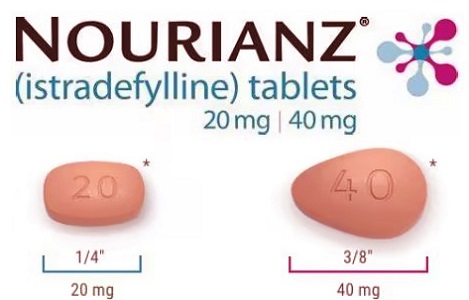Nikhil Prasad Fact checked by:Thailand Medical News Team Dec 25, 2024 3 months, 3 weeks, 5 days, 5 hours, 8 minutes ago
Medical News: Glioblastoma, the most aggressive form of brain cancer, presents a grave challenge to the medical community. This tumor’s high invasiveness and resistance to standard therapies make it a particularly daunting diagnosis. However, a recent study by researchers from the Federal University of Fronteira Sul in Brazil and the Federal University of Santa Maria has explored a new approach: targeting the A2A adenosine purinoceptor using Istradefylline, a drug already approved for treating Parkinson’s disease. This
Medical News report delves into the study’s findings, offering insights into a potentially groundbreaking strategy to tackle glioblastoma.

Istradefylline Provides New Hope Against Glioblastoma
Understanding Glioblastoma and A2A Receptors
Glioblastoma is known for its rapid growth and ability to evade the immune system. The tumor creates an immunosuppressive microenvironment, allowing it to thrive unchecked. Central to this process is adenosine, a molecule that accumulates in the hypoxic conditions of glioblastoma. Adenosine interacts with receptors like A2A, dampening immune responses and promoting tumor growth. Researchers have identified this receptor as a potential target for therapy.
The role of A2A receptors extends beyond glioblastoma. These receptors, abundant in the brain, regulate neurotransmitter release and immune responses. In the context of glioblastoma, they enable the tumor to suppress cytotoxic T cells and natural killer cells, effectively evading immune attacks. The inhibition of these receptors could thus restore the immune system’s ability to fight the tumor.
Istradefylline: A Dual-Purpose Drug
Istradefylline, originally approved by the U.S. FDA for Parkinson’s disease, works as an A2A receptor antagonist. Its primary role in Parkinson’s is to enhance dopamine signaling, alleviating motor symptoms. However, its potential extends far beyond this application. Recent studies have suggested that Istradefylline could also act as an anti-cancer agent by inhibiting the A2A receptor’s immunosuppressive effects.
This dual-purpose drug is particularly appealing because it has already been deemed safe for human use. The study’s researchers explored its effects on glioblastoma, hypothesizing that it could interrupt the tumor’s growth pathways, enhance immune responses, and improve the efficacy of chemotherapy. In this article, we’ll examine the study’s detailed findings and their implications for glioblastoma treatment.
Key Findings of the Study
The researchers conducted extensive preclinical investigations to understand how Istradefylline affects glioblastoma cells. Their experiments revealed several promising results:
-Immune Restoration: Istradefylline effectively countered the immunosuppressive environment created by glioblastoma. By blocking A2A receptors, it restored the activity of natural killer cells and cytotoxic T cells, enabling them to target the tumor more effectively.
-Reduction in
Tumor Growth: The drug inhibited pathways associated with tumor proliferation. Specifically, it reduced adenosine-mediated protective effects that shield glioblastoma cells from chemotherapy. This made the tumor cells more susceptible to treatment.
-Promotion of Apoptosis: Istradefylline induced apoptosis, or programmed cell death, in glioblastoma cells. This was a significant finding, as the tumor’s ability to avoid apoptosis is a key factor in its aggressive nature.
-Potential for Combination Therapy: The study highlighted the drug’s ability to enhance the effects of chemotherapy. By sensitizing the tumor cells, Istradefylline could improve the outcomes of standard treatments.
Broader Implications
The study’s findings suggest that Istradefylline could be a valuable addition to the glioblastoma treatment arsenal. Its ability to cross the blood-brain barrier, a major challenge for many drugs, makes it particularly suitable for treating brain tumors. Moreover, its established safety profile offers a significant advantage, potentially accelerating its integration into clinical practice.
While the focus of this research was on glioblastoma, the implications extend to other cancers as well. Adenosine-mediated immune suppression is a common feature of many tumors. By targeting this pathway, Istradefylline could be explored as a treatment for other malignancies, paving the way for broader applications.
Future Directions and Challenges
Despite the promising results, several challenges remain. The effectiveness of Istradefylline in clinical settings needs to be established through rigorous trials. Additionally, understanding the optimal dosing and combination strategies will be crucial for maximizing its benefits.
The study also raises questions about the long-term effects of A2A receptor inhibition. While restoring immune function is beneficial, excessive immune activation could lead to adverse effects. Balancing these outcomes will be a critical aspect of future research.
Conclusions
The exploration of Istradefylline as a glioblastoma treatment represents a significant step forward in oncology. By targeting the A2A receptor, this drug addresses the tumor’s ability to evade the immune system and resist chemotherapy. The study highlights its potential to improve outcomes for patients facing this devastating disease.
Moreover, the broader implications of A2A receptor inhibition suggest that Istradefylline could contribute to a paradigm shift in cancer treatment. As research progresses, this dual-purpose drug may offer hope not only for glioblastoma patients but also for those battling other cancers.
The study findings were published in the peer-reviewed journal: Brain Sciences.
https://www.mdpi.com/2076-3425/14/12/1286
For the latest Cancer News, keep on logging to Thailand
Medical News.
Read Also:
https://www.thailandmedical.news/news/repurposed-cancer-drugs-offer-hope-for-glioblastoma-treatment
https://www.thailandmedical.news/news/amino-acid-deprivation-as-a-new-hope-in-glioblastoma-treatment
